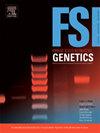FamLink2 – A comprehensive tool for likelihood computations in pedigrees analyses involving linked DNA markers accounting for genotype uncertainties
IF 3.2
2区 医学
Q2 GENETICS & HEREDITY
引用次数: 0
Abstract
There is an increasing demand for software that can handle an arbitrary number of linked markers in forensic genetics; primarily with application to inference of relationships and direct matching but also in applications such as ancestry inference and mixture interpretation. With the emergence of sequencing technologies, denser sets of SNP markers are generated and analyzed. Additionally, sequence data of low quality and quantity DNA generate uncertainty about the underlying true genotype. We provide an efficient implementation of a general model for pedigree likelihood computations with genetic marker data using a three-layered approach. The top and first layer is the population model where allele frequencies and population substructure are accounted for. The second layer is the inheritance model which efficiently handles linked markers using an IBD model. The third and bottom layer is the observational level where we model the likelihood of the true genotype given underlying reads as well as parameters for errors. We exemplify the utility of our implementation as well as provide validation according to guidelines established by the ISFG using a combination of two published SNP panels. We demonstrate that computations are feasible for panels encompassing 10,000 markers and we argue that, due to the properties of the underlying algorithm, extending the number of markers will result in a linear increase in computation time. In addition we study the impact of parameters used in our model and suggest some guidelines pertaining to their values. The results demonstrate that a probabilistic model for low coverage sequence read data is needed instead of relying on an a threshold based genotype and applying our general model for inference of relationships on a real case can be superior, i.e. higher information content, to other methods relying on either fixed genotypes with low quality sequence data or simple pair wise relationship tests. In summary, the implementation, FamLink2 (freely available at https://famlink.se), can jointly handle genetic linkage, genotype uncertainty and population substructure for an arbitrary pedigree with data for any number of individuals. Whereas the current study will focus on calculations disregarding mutations, FamLink2 has the ability to model mutations for certain built-in pedigrees.
FamLink2 - 在涉及基因型不确定性的关联 DNA 标记的血统分析中进行可能性计算的综合工具
在法医遗传学中,对能够处理任意数量关联标记的软件的需求越来越大;这些软件主要应用于关系推断和直接匹配,也可应用于祖先推断和混合物解释等。随着测序技术的出现,产生和分析的 SNP 标记集越来越密集。此外,低质量和低数量的 DNA 序列数据会对潜在的真实基因型产生不确定性。我们采用三层方法为遗传标记数据的血统似然计算提供了一个通用模型的高效实现。第一层是种群模型,其中考虑了等位基因频率和种群亚结构。第二层是遗传模型,利用 IBD 模型有效处理关联标记。第三层也是最底层是观察层,我们在这一层中根据基础读数和误差参数对真实基因型的可能性进行建模。我们举例说明了我们的实现方法的实用性,并根据 ISFG 制定的准则,使用两个已发布的 SNP 面板组合进行了验证。我们证明了对包含 10,000 个标记的面板进行计算是可行的,而且我们认为,由于底层算法的特性,标记数量的增加将导致计算时间的线性增加。此外,我们还研究了模型中使用的参数的影响,并提出了一些有关参数值的指导原则。结果表明,低覆盖率序列读数数据需要一个概率模型,而不是依赖于基于阈值的基因型,在实际案例中应用我们的通用模型进行关系推断,比其他依赖于低质量序列数据的固定基因型或简单配对关系测试的方法更有优势,即信息含量更高。总之,FamLink2(可在 https://famlink.se 免费获取)的实现可以联合处理具有任意数量个体数据的任意血统的遗传联系、基因型不确定性和种群亚结构。目前的研究将重点放在不考虑突变的计算上,而 FamLink2 具有为某些内置血统建立突变模型的能力。
本文章由计算机程序翻译,如有差异,请以英文原文为准。
求助全文
约1分钟内获得全文
求助全文
来源期刊
CiteScore
7.50
自引率
32.30%
发文量
132
审稿时长
11.3 weeks
期刊介绍:
Forensic Science International: Genetics is the premier journal in the field of Forensic Genetics. This branch of Forensic Science can be defined as the application of genetics to human and non-human material (in the sense of a science with the purpose of studying inherited characteristics for the analysis of inter- and intra-specific variations in populations) for the resolution of legal conflicts.
The scope of the journal includes:
Forensic applications of human polymorphism.
Testing of paternity and other family relationships, immigration cases, typing of biological stains and tissues from criminal casework, identification of human remains by DNA testing methodologies.
Description of human polymorphisms of forensic interest, with special interest in DNA polymorphisms.
Autosomal DNA polymorphisms, mini- and microsatellites (or short tandem repeats, STRs), single nucleotide polymorphisms (SNPs), X and Y chromosome polymorphisms, mtDNA polymorphisms, and any other type of DNA variation with potential forensic applications.
Non-human DNA polymorphisms for crime scene investigation.
Population genetics of human polymorphisms of forensic interest.
Population data, especially from DNA polymorphisms of interest for the solution of forensic problems.
DNA typing methodologies and strategies.
Biostatistical methods in forensic genetics.
Evaluation of DNA evidence in forensic problems (such as paternity or immigration cases, criminal casework, identification), classical and new statistical approaches.
Standards in forensic genetics.
Recommendations of regulatory bodies concerning methods, markers, interpretation or strategies or proposals for procedural or technical standards.
Quality control.
Quality control and quality assurance strategies, proficiency testing for DNA typing methodologies.
Criminal DNA databases.
Technical, legal and statistical issues.
General ethical and legal issues related to forensic genetics.

 求助内容:
求助内容: 应助结果提醒方式:
应助结果提醒方式:


